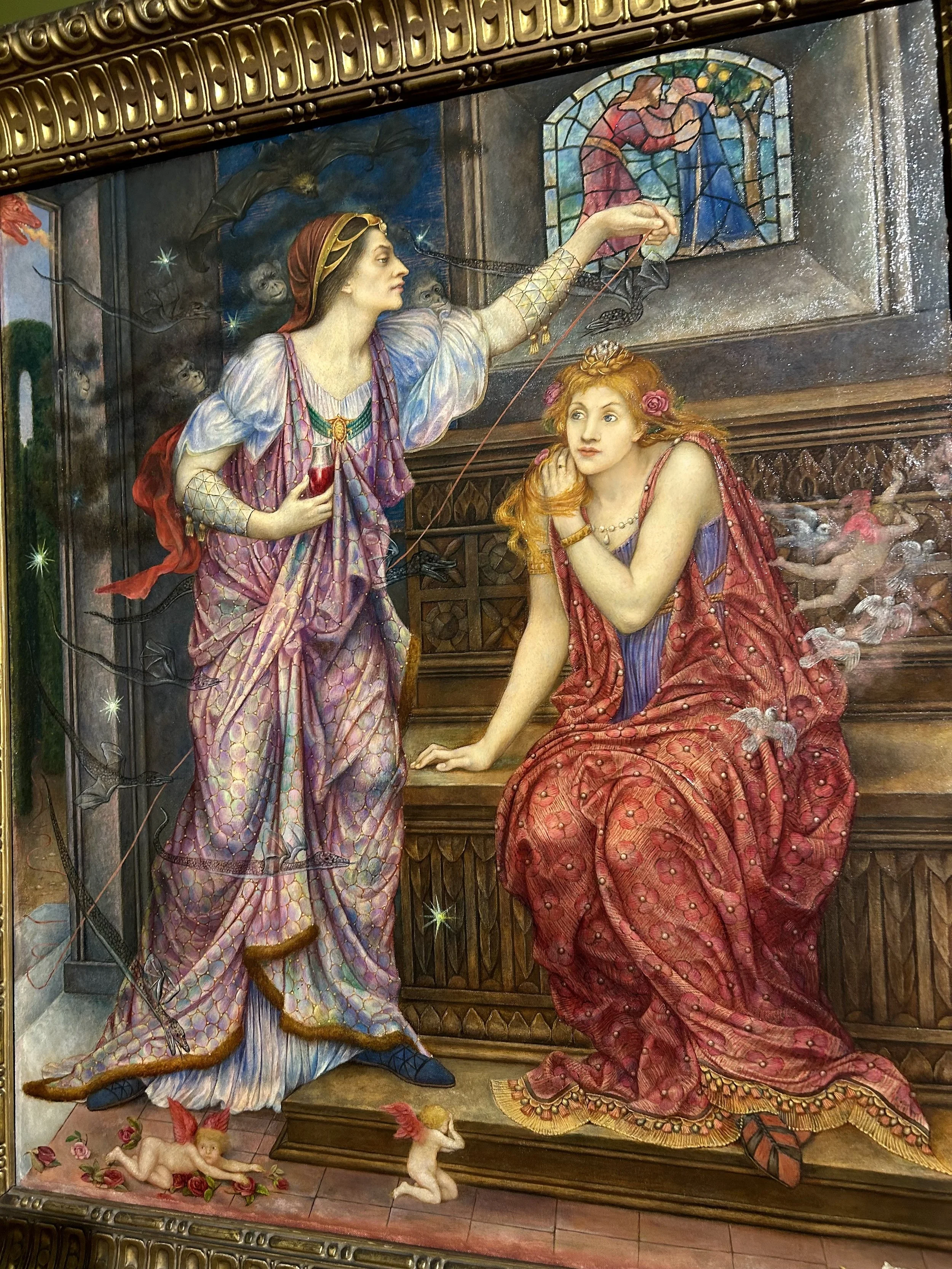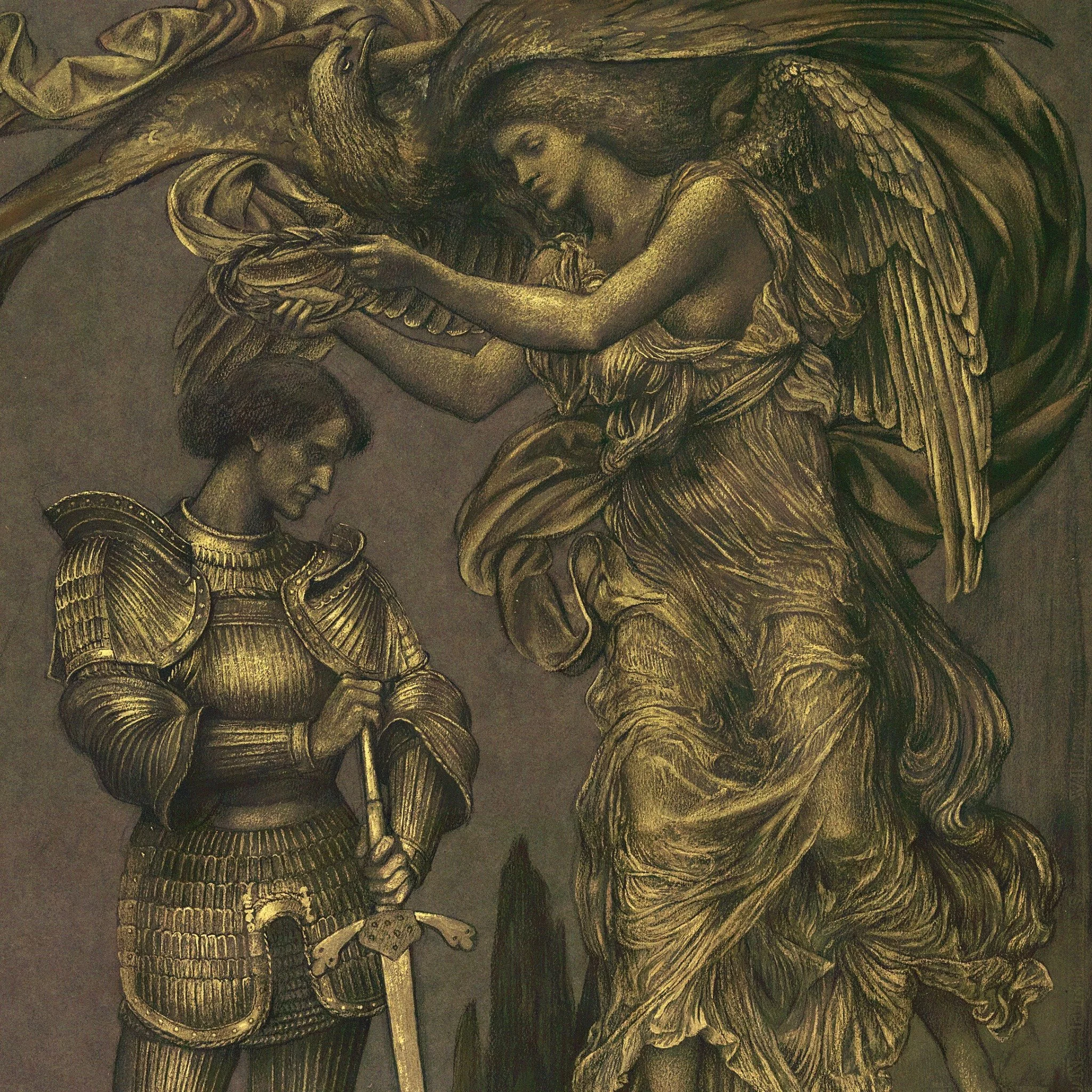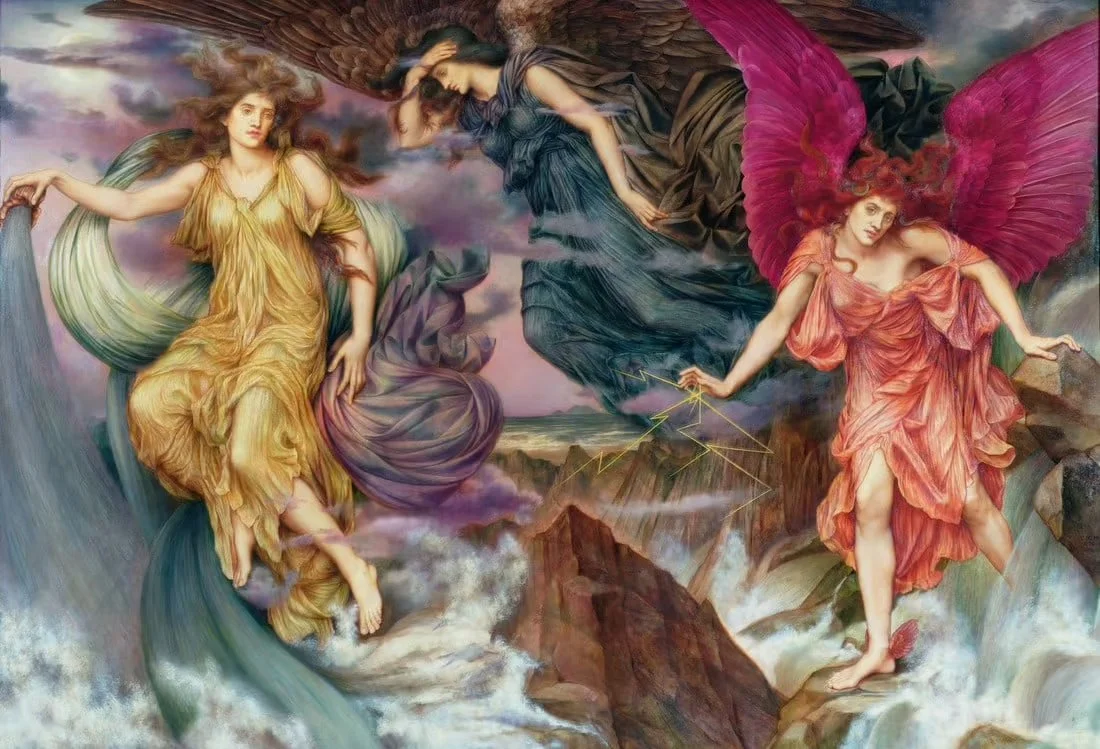Aurelia Reviews: Evelyn De Morgan at the Guildhall Gallery
A Victorian ‘Queen’
What happens when a Pre-Raphaelite mind meets feminist courage and a spiritual imagination? The answer is the visionary Evelyn De Morgan. Forget what you know about Victorian women. De Morgan was so ahead of her time that her work remains just as potent today. My concluding comments demonstrate how her work questions our modern day experiences.
Sisterhood and the City
Located in the historic heart of the City of London, the Guildhall Art Gallery is marked by a beautiful approach. It looks onto a courtyard with outdoor café seating, to enjoy the splendour of the surrounding architecture. Tucked away from the hustle and bustle of finance bros, tech nerds and salesmen, the tranquillity has its benefits. However, it is a little tricky to find if you don’t know what you’re looking for. I initially ended up walking into, and being escorted out of, the ceremonial and administrative centre of the Guildhall round the corner.
The gallery houses the City’s official art collection, covering over 400 years of British painting. The permanent collection celebrates the cultural and civic life of London, with a particularly strong selection of Victorian art. Therefore, Evelyn De Morgan’s Pre-Raphaelite work builds upon the rest of the collection. One of the gallery’s most distinctive features is its underground Roman amphitheatre, discovered in 1988, offering an unexpected encounter with London’s multi-layered history.
The Evelyn De Morgan special exhibition runs from 4th April 2025 – 4th January 2026. Many of the artworks on display are sourced from the De Morgan Foundation. Unlike most special exhibitions in London, admission is free, and I was pleased by the inclusivity of the "Pay What You Can" entry.
De Morgan in a Nutshell
Evelyn De Morgan (1855–1919) was a British painter associated with the later phase of the Pre-Raphaelite movement. Born Mary Evelyn Pickering in London into an upper-middle-class family, she demonstrated artistic talent from a young age. Despite societal expectations for women of her class, she pursued a professional artistic career. Spirituality, classical mythology, and allegory were at the heart of her work, exploring themes such as life, death, and the soul’s journey. In 1887, she married ceramicist William De Morgan, and together they became involved in the Spiritualist movement. She died in 1919, but her legacy lives on: De Morgan challenged conventions within a male-dominated art world, paving the way for feminist artists of later generations.
The final section highlights De Morgan's enduring legacy, showcasing ceramics by her husband, William De Morgan, and exploring the history of the De Morgan Foundation. This segment underscores the couple's collaborative influence on the Arts and Crafts movement, and it was fascinating seeing the breadth of her creativity. As many female Victorian artists were overshadowed by their artist husbands, it was great to see her husband featured very much as a like-minded support and not a rival.
An Obsession with Materials
Most of De Morgan’s works were painted in oil on canvas, the standard medium for Victorian fine art. However, she painted with a unique hand, aiming for luminosity and intricate detail. She often applied layered glazes, a technique derived from Renaissance painting, for the illusion of depth and radiance. This method allows light to pass through translucent layers of colour, giving her figures an incandescent quality. She avoided impasto textures, favouring a smooth, polished surface, emulating the clarity of texture of early Renaissance art.
De Morgan had a distinctive colour palette, which was not purely decorative, but enhanced the emotionally evocative and symbolic nature of her work. Jewel tones and shadowy tenebrosity evoke mystery, divinity, or danger. Creamy whites and golds allude to purity, hope and beauty.
Evelyn De Morgan, Queen Eleanor and Fair Rosamund, 1901-1902, Guildhall Gallery, London.
Poignant Pastels
While Evelyn De Morgan is best known for her oil paintings, she also created pastel works, though these are fewer in number and less widely discussed. However, I think her pastels reveal much about her technical skill and these were entrancing to look at. They not only exist as studies, but also as standalone works, creating more intimate and experimental pieces. Pastels may have offered her a more spontaneous way to develop ideas, and a more economical form of exploration.
Her pastel works retain that characteristic ethereal glow seen in her paintings, with the medium’s softness lending itself to dream-like subjects. She was often using pale pastels on dark paper, in a kind of reverse chiaroscuro, which creates a unique mood and aura. Her handling of the medium was delicate yet confident, rendering forms solidly and yet achieving the translucency of drapery or glowing skin.
Evelyn De Morgan, Victoria Dolorosa (detail) 1900, gold pastel and chalk on paper, Leighton House, London.
How to admire her work - (some good, old fashioned Visual Analysis…)
Though not one of her more frequently reproduced works, Storm Spirits is a compelling example of De Morgan's symbolist imagination, and her gift for turning elemental forces into spiritual allegory. The spirits represent the chaos of nature and emotional turbulence, externalising inner states through mythological imagery.
The storm is not just a physical event, but a psychic phenomenon, perhaps representing the trials of the soul. Like many of her works, it pivots around female figures. They are not passive muses, but active, commanding forces, showing De Morgan’s feminist reimagining of myth. The colour palette is dominated by dark, moody blues and greys, evoking a sense of intensity and movement, whilst also projecting the figures in dazzling red and yellow garments. Lightning streaks across the sky, and waves crash below, contributing to the painting’s charged atmosphere.
Evelyn De Morgan, Storm Spirits, 1900, Guildhall Gallery, London.
The Curatorial
The exhibition is structured thematically, rather than in a strictly chronological fashion. Perhaps this is to resonate with the philosophy of De Morgan’s vision, guiding the viewer through evolving spiritual and cultural ideas. The exhibition’s wine-red wall colour evokes both the traditional, institutional hang and Victorian aesthetics. The hue sets a tone of dignity and austerity, but also draws out the warmth of De Morgan’s palette. Within the spacious gallery, the hang is generous but not cluttered, with larger, prominent works given the gravitas of breathing room.
All in all, I found the exhibition comprehensive and easy to follow. Curatorially, it is strong, with a significant amount of accompanying information. The visitor is reminded of historical context and how De Morgan fit into what was happening culturally in Victorian Britain and the more exclusive the art movement. It might have been nice to link her work to contemporary artist and her legacy – or how she might be more directly relevant to the current cultural scene.
Connecting the Contemporary
The exhibition features recreations by contemporary artist Paul Francis Walker of two paintings lost in a 1991 warehouse fire. Although these are interesting to see compositionally, the colours and the rendering of the forms are noticeably different to De Morgan. The overall quality seems a little jarring in contract to her true artworks. I am usually always a fan of combining historical and contemporary artwork if there is an interesting dialogue between the works. However, I was left feeling slightly unclear of the purpose of trying to faithfully copy something which is impossible to recreate. Moreover, I was surprised to see a male artist chosen for this dialogue. It might have been interesting to see a visual dialogue with a contemporary female artist inspired by De Morgan’s legacy and the missing works.
Why does her work matter now?
The Guildhall Gallery is nestled amongst the modernity of the City of London, which stands as a global hub of innovation and diversity. As the UK reckons with its colonial past and its systemic inequalities, it is crucial to highlight the lives and work of women like De Morgan, who suffered from historical patriarchal systems. In all her brilliance, she represents the kind of voice we’re only now learning to listen to.
In the chaos of our modern age, Evelyn De Morgan’s art feels more relevant than ever. In a society that is currently characterised by secularism and technological overload, there is an ever-growing collective longing for spiritual connection. As mindfulness practices, spirituality, in many forms, continue to grow in popularity, many are seeking conversations surrounding ‘self’.
De Morgan invites us to ask…
What do we truly value? What kind of world are we building? How do we honour the soul in a time of crisis?
We can establish that art that is beautiful and mystical is not just decoration, but it is also resistance, transformation, and healing. We can learn that art is the voice of an individual spirit and of a community. We also are reminded that women’s narratives and perspectives matter profoundly and are still fighting to be heard. De Morgan’s paintings give us a language for grief, hope, transcendence, and quiet power, in a world that often feels fractured.
Visiting Info:
Free Admission: The exhibition operates on a "Pay What You Can" basis, allowing visitors to contribute an amount of their choosing.
Open daily from 10am to 5pm.
Free introductory tours available every day, Tuesday to Sunday, at 12:15pm and 1:15pm and last 30-45 minutes. No booking is required.


